Photography Opportunities on the Annapurna Region Treks

The Himalayas have long been a home for adventure seekers. Still, for photographers, the region offers something unique, a chance to capture awe-inspiring landscapes, rich cultural experiences, and unforgettable moments. My first trek through the Annapurna Region was a life-changing experience. Armed with a camera, I started with the expectation of photographing towering mountains, but I didn’t anticipate the sheer diversity of scenes that unfolded at every turn.
From tranquil lakes reflecting the snow-capped peaks to vibrant village life and deep, rugged valleys, the Annapurna Region is a treasure trove for any photographer. Whether you’re an experienced photographer with a DSLR or a traveler armed with a smartphone, the Annapurna Region offers some of the most photogenic spots in the world.
Must Click Photos on the Annapurna Circuit Trek
The Annapurna Circuit Trek, known for its scenic diversity and adventure, takes you through lush valleys, alpine forests, remote villages, and high mountain passes. The vast array of landscapes and cultural experiences makes it one of the most photographically rewarding treks in the world. Here are some key photography spots to watch for along the way.
Thorong La Pass
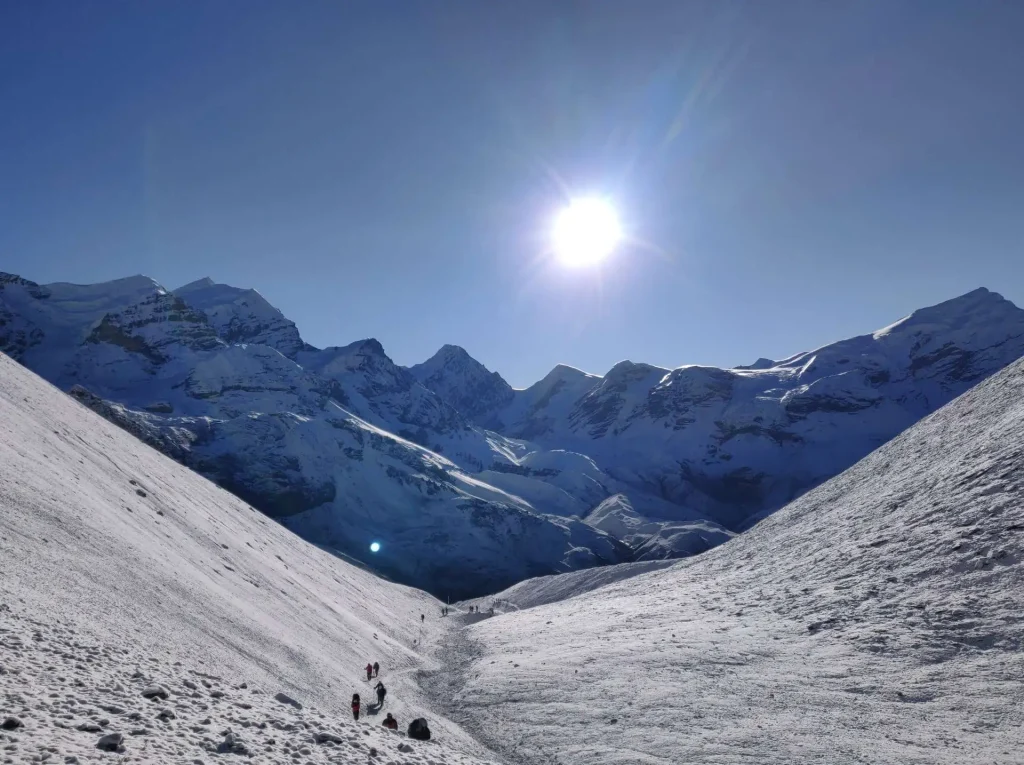
Reaching the top of Thorong La Pass at 5,416 meters is a significant achievement for any trekker, but it’s also a photographer’s dream. The panoramic views from the pass are simply breathtaking. The entire horizon is dominated by towering peaks, glaciers, and deep valleys. For adventure photographers, shots of trekkers braving the snow-covered paths add a sense of scale and challenge to your portfolio.
Tip: The altitude and cold temperatures can drain camera batteries quickly, so bring extra batteries and keep them warm inside your jacket. I used duct tape to block the cold air into the battery. Consider investing in a lightweight, travel-friendly tripod like the Manfrotto Befree for stabilizing your shots in these conditions.
Crossing Suspension Bridges
Suspension bridges are iconic features of the Annapurna Circuit Trek, and they offer plenty of action-packed photo opportunities. Some of these bridges stretch across deep gorges with rivers roaring below, making for dramatic shots. You can capture the thrill of trekking by photographing companions crossing these bridges, surrounded by mountains and dense forests.
Tip: Use a slow shutter speed to capture the motion of the river below and ensure your camera is on a tripod to avoid any motion blur.
Mountain Views
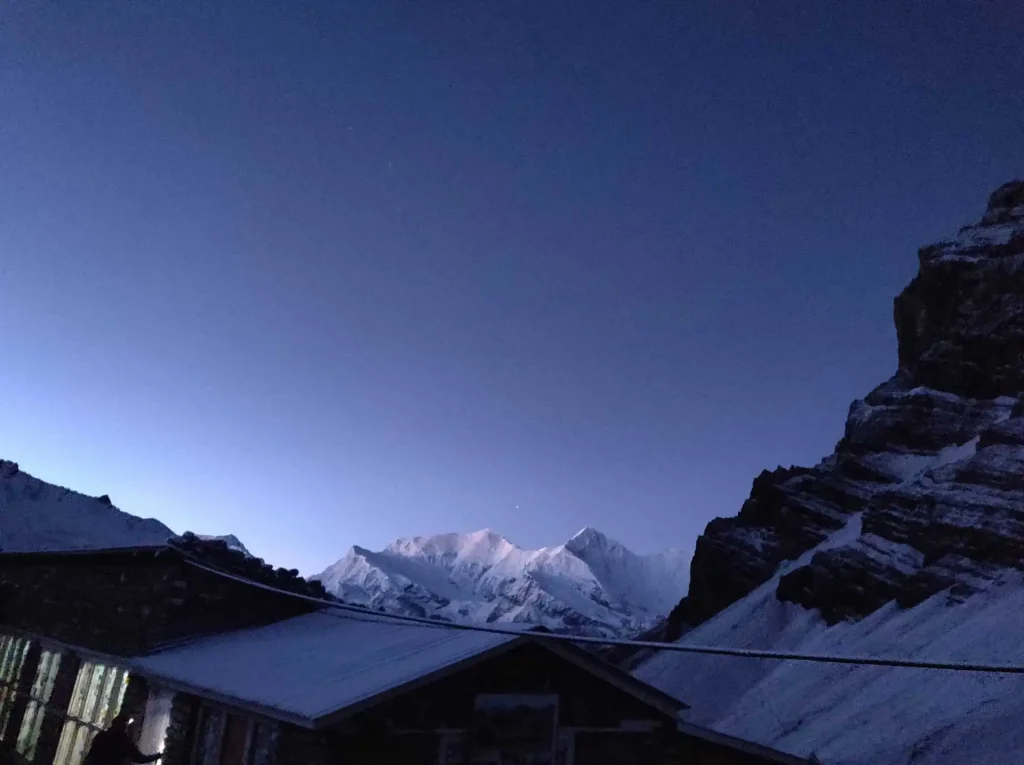
As the Annapurna Circuit is a long trek, you will get plenty of opportunities to capture the mountains. One of the most rewarding experiences along the Annapurna Circuit is watching the sun rise and set over the Annapurna Massif. The sight of these majestic peaks silhouetted against a vibrant orange or pink sky is something every photographer dreams of capturing. Early morning and late evening lights create a natural spotlight on the snow-capped peaks, highlighting their textures and making them appear even more imposing.
Tip: Set up early and have your camera ready as the light changes quickly. Use a tripod for those sunrise and sunset shots to stabilize your camera for the best results.
Trekking Portraits

The Annapurna Circuit is as much about the people as it is about the landscapes. Portraits of local villagers, monks, and your fellow trekkers can tell a powerful story. The diversity of faces and expressions you’ll encounter, whether it’s a weather-beaten elderly man or a young child smiling in a remote village can add a human touch to your photographic collection.
Tip: When photographing people, always ask for permission first and respect their privacy. Capture candid moments that reflect their daily lives and experiences.
Breathtaking Waterfalls

Throughout the lower sections of the Annapurna Circuit, you’ll encounter numerous waterfalls cascading down cliffs. Depending on the season, these waterfalls range from gentle streams to thunderous torrents, especially during the monsoon months. Capturing the motion of the water—whether in a sharp freeze-frame or as a soft blur—can result in some stunning images.
Tip: Try capturing the motion of waterfalls. Ensure your camera is on a tripod to avoid any motion blur.
High-altitude Lakes
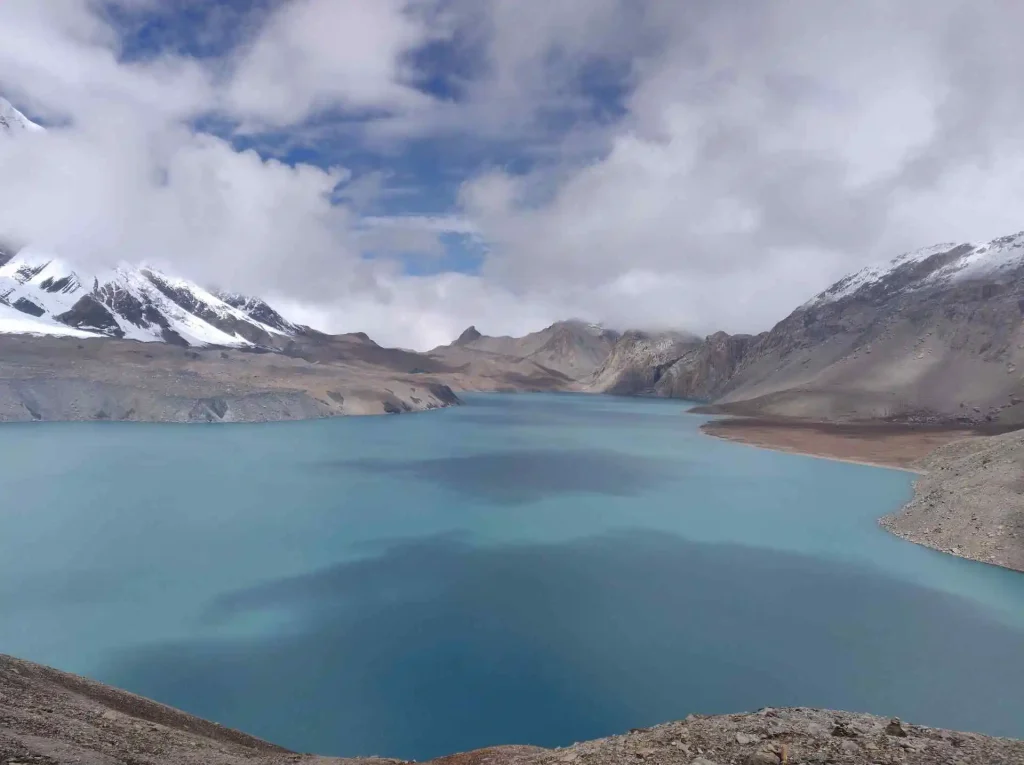
One of the highlights for photographers on the Annapurna Circuit is visiting Tilicho Lake, one of the highest lakes in the world at 4,919 meters. Its crystal-clear blue waters reflect the snow-capped peaks surrounding it, offering a serene yet dramatic scene to capture. The lake, surrounded by barren, rocky landscapes, is a must-see and must-shoot for anyone trekking through the region.
Tip: To capture the reflection of the mountains on the lake’s surface, make sure to visit early in the morning when the water is calm, and the light is softer.
Scared Muktinath Temple
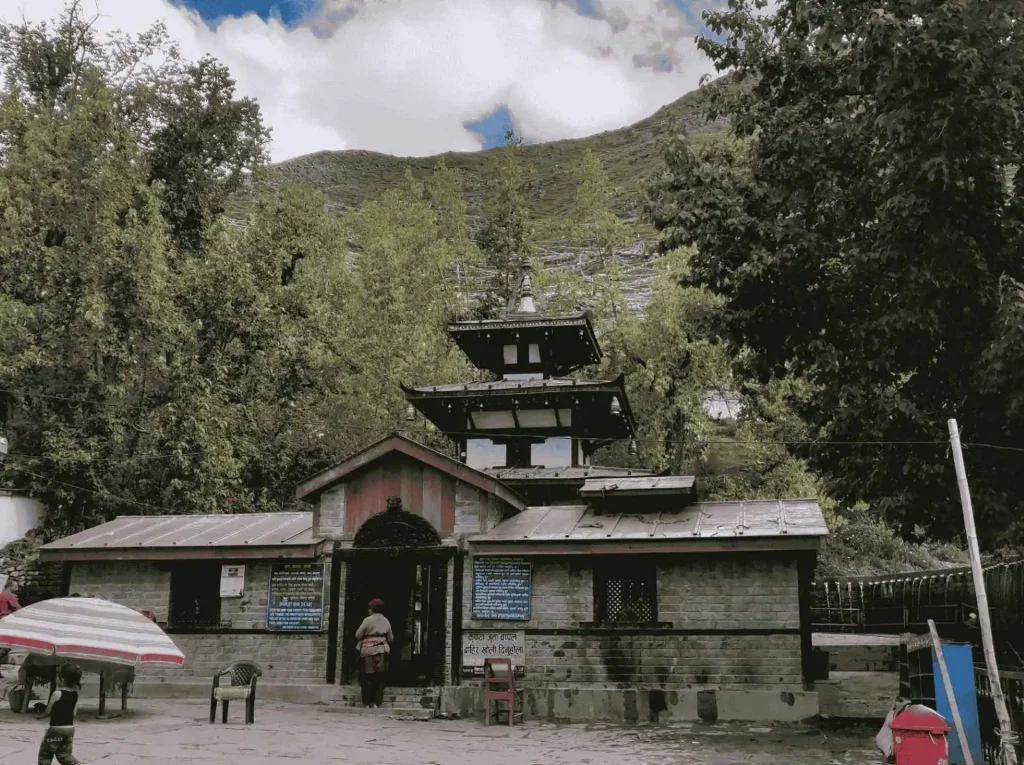
Photographing the spiritual side of the Annapurna Circuit is an enriching experience. The Muktinath Temple, a sacred pilgrimage site for Hindus and Buddhists, is a place of deep spirituality and offers a unique contrast to the harsh, rugged landscape around it. The temple, itself is an architectural beauty where pilgrims love to capture pictures.
You can also take pictures of the eternal flame, holy water sprouts, prayer flags, and devotees performing their rituals. After sunset, the temple is often lit with candles and oil lamps creating a spiritual atmosphere.
Tip: Respect the spiritual significance of the site and seek permission before photographing ceremonies or religious artifacts.
Himalayan Wildlife
While trekking the Annapurna Circuit, keep an eye out for the unique wildlife that inhabits the region. You might spot a Himalayan tahr (a wild goat native to the Himalayas) or, if you’re very lucky, the elusive snow leopard. Birdwatchers will delight in the sight of brightly colored Impeyan pheasants, Nepal's national bird, as well as other rare bird species.
Tip: Wildlife photography requires patience. Carry a zoom lens and be prepared for long waits to capture elusive animals in their natural habitat.
Traditional Nepali Villages

The Annapurna Circuit takes you through many traditional Nepali villages like Manang and Pisang, where the architecture and way of life have remained largely unchanged for centuries. You will encounter various local settlements including Gurung, Magar, and Thakalis along the way. Photographing the terraced fields, stone houses, and traditional prayer flags fluttering in the wind can offer a glimpse into the rich cultural heritage of the region.
If you are trekking during the festive period, you can capture the celebrations and festivals as locals observe them.
Tip: Be mindful of cultural sensitivities and seek permission before photographing people in their homes or during private moments.
Visit Ice Lake

For those with an adventurous spirit, a visit to Ice Lake is worth it. The lake, located in the Manang, offers some of the clearest and most stunning high-altitude landscapes in the area. The tranquility and stillness of the lake, with towering peaks reflected in its glassy waters, make for some spectacular images.
Tip: Use a wide-angle lens to capture the vastness of the landscape and the reflections on the lake’s surface.
Must Click Photos on the Annapurna Base Camp Trek
The Annapurna Base Camp Trek or ABC Trek takes you right into the heart of the Himalayas. With Annapurna I, the world’s 10th highest peak, looming overhead, every direction offers a photo opportunity. The trek also passes through rhododendron forests, rivers, and traditional villages, each offering a new perspective on the beauty of Nepal.
Sunrise Over Machapuchare Mountain
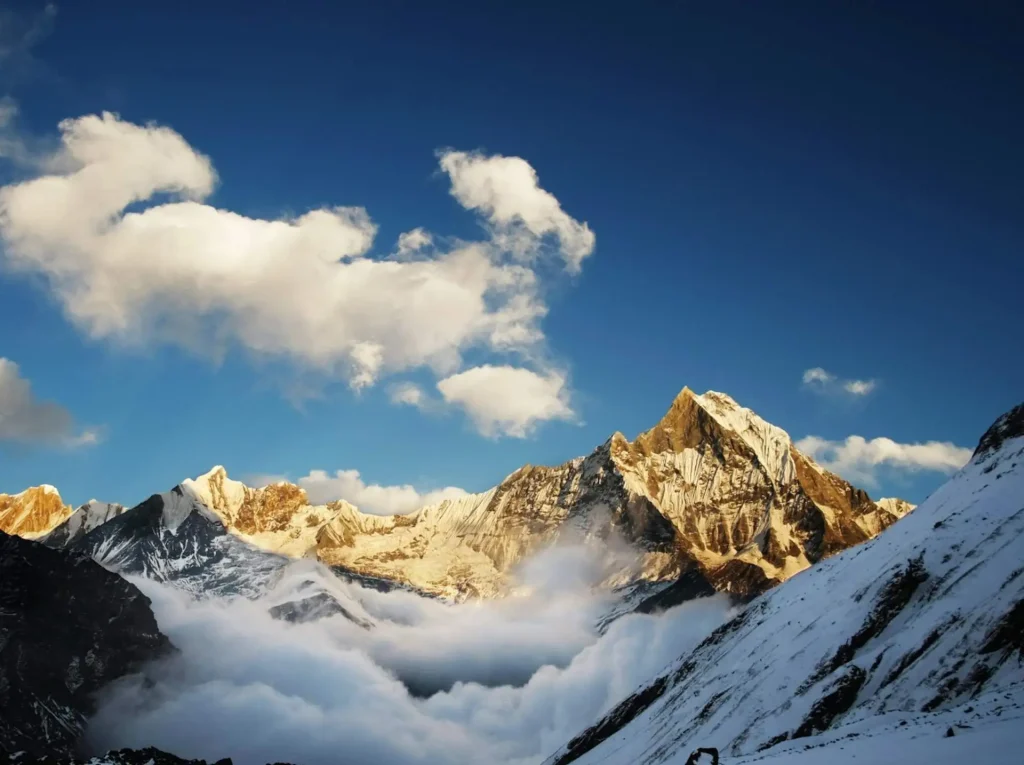
The iconic Machapuchare, or "Fishtail Mountain," is one of the most recognizable peaks in Nepal. Sunrise over mountains is magical. Capturing the sunrise over Machapuchare is an absolute must for photographers trekking to Annapurna Base Camp. As the first rays of sunlight hit the peak, it glows bright orange, offering a dramatic contrast to the surrounding darker peaks.
Tip: Set up early and use a tripod to capture the changing colors and details of the sunrise. A wide-angle lens will help you include the peak and the surrounding landscape in your frame.
The Booming Rhododendrons
In the spring, the rhododendron forests that line the Annapurna Base Camp Trek come alive with color. The trail passes through lush subtropical forest areas, where you will find various species of rhododendrons.
From March to May, the forests get adorned with vibrant red, pink, and white blooms, making the trail feel like a magical garden. Capturing this explosion of color with the snowy peaks in the background creates a breathtaking contrast. The falling of multi-colored flowers covers the trails, creating a beautiful scene.
Tip: Use a macro lens to get close-up shots of the flowers and capture the intricate details and vibrant colors.
Annapurna I at Sunset
At Annapurna Base Camp, the peaks of the Annapurna Massif surround you. One of the best times to capture the majesty of Annapurna I is at sunset when the last light of the day casts a golden glow on the mountain’s face. The play of light and shadow creates a dramatic effect, turning the peak into a glowing beacon.
Tip: Capture the changing colors of the sunset by experimenting with different exposures and angles. A polarizing filter can help reduce glare and enhance colors.
Traditional Gurung Village

One of the cultural highlights of the trek is passing through Gurung villages, where you can capture images of traditional stone houses, terraced fields, and local villagers going about their daily lives. Gurungs are known for their hospitality, unique culture, and houses, with intricately carved wooden windows and steeply pitched roofs. Annapurna Base Camp Photos will be incomplete without capturing the Gurung villages.
Ghandruk, a village on the way to Annapurna Base Camp, is particularly picturesque, offering opportunities to photograph the cultural heritage of the Gurung people.
Tip: When photographing villagers, approach them with respect and interest. Share your photos with them as a sign of goodwill.
Suspension Bridges
Suspension bridges are again a photographic feature of the Annapurna Base Camp Trek, and capturing trekkers crossing these bridges, framed by towering peaks and rushing rivers, adds a sense of adventure to your photography. The bridges in this region often come with prayer flags fluttering in the wind, adding vibrant colors to your shots. As a part of the trek experience, you should take some candid shots of yourself crossing these bridges.
Tip: Use a high shutter speed to freeze the motion of the trekkers and the fluttering flags, and consider a low angle to emphasize the height of the bridge.
Fluttering Prayer Flags

Prayer flags are a common sight along the Annapurna Base Camp Trek. These colorful flags, often strung across mountain passes and sacred sites, add vibrant splashes of color against the backdrop of the snow-capped peaks. Capturing the fluttering flags with the mountains in the background creates a powerful image of spirituality and peace.
Tip: To capture the motion of the flags, use a faster shutter speed to freeze their movement or a slower speed to create a sense of motion.
Trekking Companions and Porters
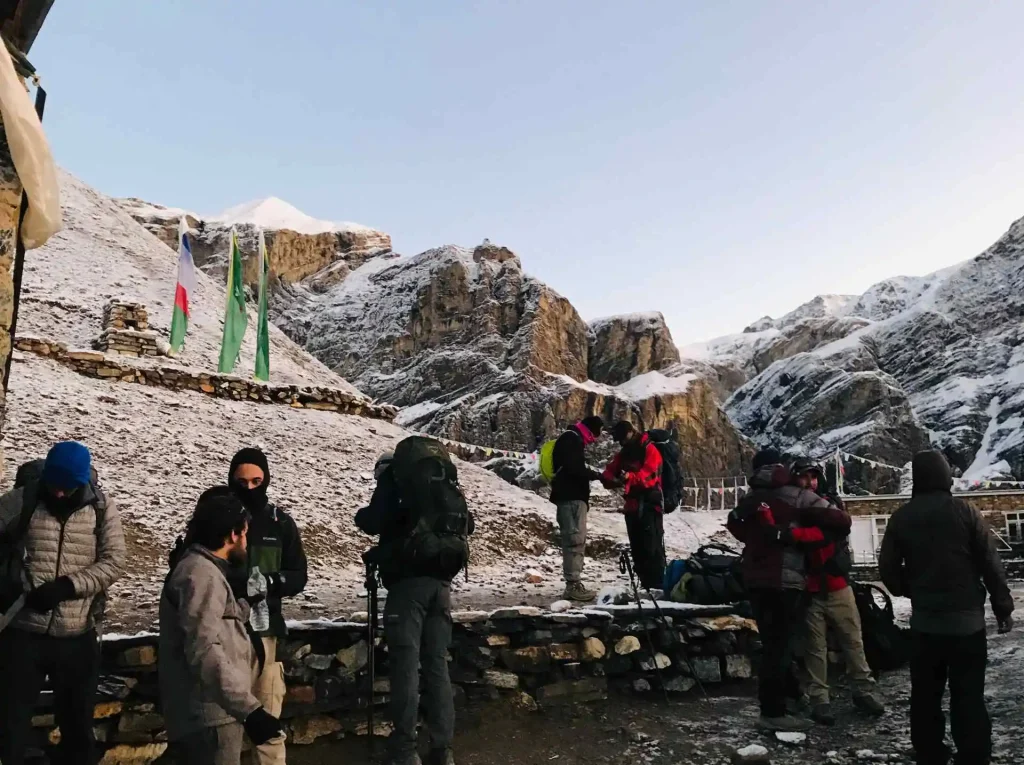
The people who support you along the trek—your porters and fellow trekkers—are an integral part of the journey. Photographing these individuals not only captures the essence of the trek but also adds a personal touch to your photographic story. Their interactions, strength, and camaraderie are worth documenting.
Tip: Share your photos with your trekking companions and porters as a gesture of appreciation. They will likely be pleased to see themselves featured in your adventure.
Conclusion
Final Thoughts: Why the Annapurna Region is a Photographer’s Paradise
Trekking in the Annapurna Region is more than just an adventure, it’s an immersive experience that combines awe-inspiring landscapes with cultural richness. Whether you’re an avid photographer or someone who simply enjoys capturing moments on your phone, the opportunities for stunning shots are endless. From the towering peaks of the Annapurnas to the vibrant life of the villages below, every moment on the trail is a chance to create lasting memories through photography.
So pack your camera, lace up your trekking boots, and get ready to capture the beauty of the Annapurna Region. The Himalayas await with their timeless charm and unparalleled photographic opportunities.
